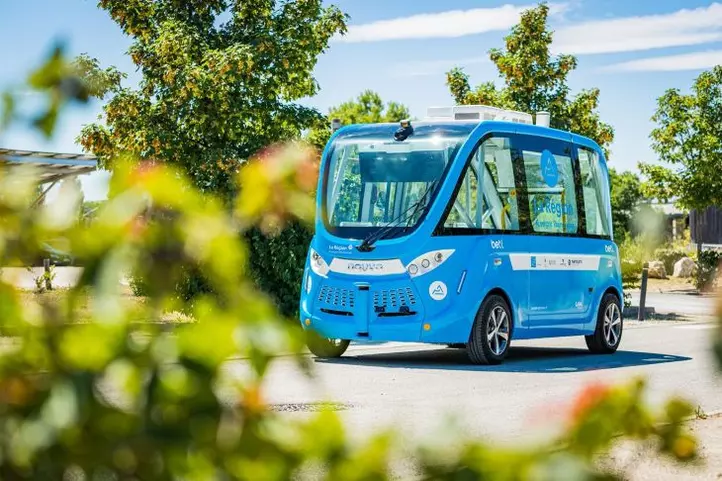Kicking off the Italian trial of self-driving buses and shuttles was the city of Merano, through funds made available by the European cross-border cooperation project Mentor: the South Tyrolean centre tested the self-driving public transport solution in 2019 for one week, from 25 November to 1 December. The people of Merano were able to try out the self-driving shuttles along a route lasting a total of ten minutes through the streets of the historic centre, starting at via dei Giardini. The vehicle used for these first tests was provided by the French company Navya: capable of accommodating fifteen people on board (eleven seated users and four standing), including the company's operator assigned to intervene in case of need and ready to answer any questions from passengers, the electric bus moves autonomously at a speed of 25 km/h thanks to a complex set of sensors, cameras, RTK (real-time kinematic) GPS and IMU (inertial measurement unit).
Based on odometry, the shuttle processes images of the route in real time, avoiding potential obstacles and adjusting the route accordingly. The margin of error of the chosen bus is only one centimetre: with an autonomous driving level four (on a scale of 5), it is in fact designed to move in well-defined and limited spaces such as the streets of a historic city centre.
Citizens who took advantage of the trial service said they were excited and were looking forward to finding out the future developments of this solution for their city. Should these buses be adopted as public transportation, they would have to connect not only the different neighbourhoods of the city, but also the many locations around the municipality: an application that must therefore take into account the complex alpine geography of this area.
Following Merano was the city of Bari, which approved the trial on 14 April 2021, under the Ministry of Economic Development's (MiSe) Emerging Technologies Support Programme. Trial tests are scheduled during 2022, along a selected route in the historic centre of Puglia's capital city. The self-driving shuttles identified for the Bari trial are the same as those used in the Merano example, with similar physical characteristics and an estimated travel range of around ten hours. For the municipality of Bari, self-driving public transportation could be an effective solution with a dual application: the buses and shuttles would carry out passenger transport during the day and monitoring activities, in compliance with regulations on the protection of privacy, at night. An opportunity to redefine smart and sustainable mobility in Bari, while also attracting entrepreneurial talent and investment for the sector.
Turin will be able to experiment with self-driving transportation on its territory thanks to funds released by the project Sperimentazione Italia of the Ministry of Technological Innovation. The route that the two shuttles available to the Piedmontese capital will take runs of five kilometres between the City of Health and Science hospitals. Between March and April 2022, the so-called pre-demo phase was initiated: the solution was tested without passengers on board, to allow the vehicle to visualise and memorise the route to be taken. Then, the citizens of Turin will have a chance to test the innovative solution for five months during 2022. For the Turin experience, the aim is to adapt Navya's engineering and sensor system to the realities of the selected route by having the shuttle communicate with traffic lights to ensure right of way at intersections.
Starting in December 2022, it will be Rome's turn: in fact, the EUR district will be the scene of the self-driving transportation trial, as part of the national MaaS (Mobility as a Service) project. In this case, the maximum number of passengers aboard the shuttles in use will be 12, and if tests prove successful, the solution will also be adopted for the streets of the historic centre, one of the world's busiest areas. The specific route, which is envisioned to connect the neighbourhood's public and private hubs, from the municipal offices to Piazzale degli Archivi, passing through Via della Civiltà del Lavoro and the Nuvola Convention Centre, will be identified and properly marked. In the cases mentioned so far, the trials will all make use of Navya shuttles (see photo below, a Navya autonomous shuttle in France, credit Bertolami, E.N.).
With resources made available by the national MaaS project, also Milan will implement a number of advanced technologies along the route of the 90-91 line, a fast lane for public transportation, as an alternative to traditional mobility. Self-driving vehicle systems will be used, not only buses and shuttles but also cars, and intermodality is possible at some stations. Circulating at Viale Abruzzi will be the Tech bus, the first trolleybus with assisted driving, created as part of the Joint Research Lab project for urban mobility: through the 5G connection, sensors installed on board the car will be able to communicate with traffic lights and road infrastructure, so-called vehicle to infrastructure communication (V2I), updating the driver in real time on the conditions of the route, the presence of obstacles and any other vehicles in transit.

